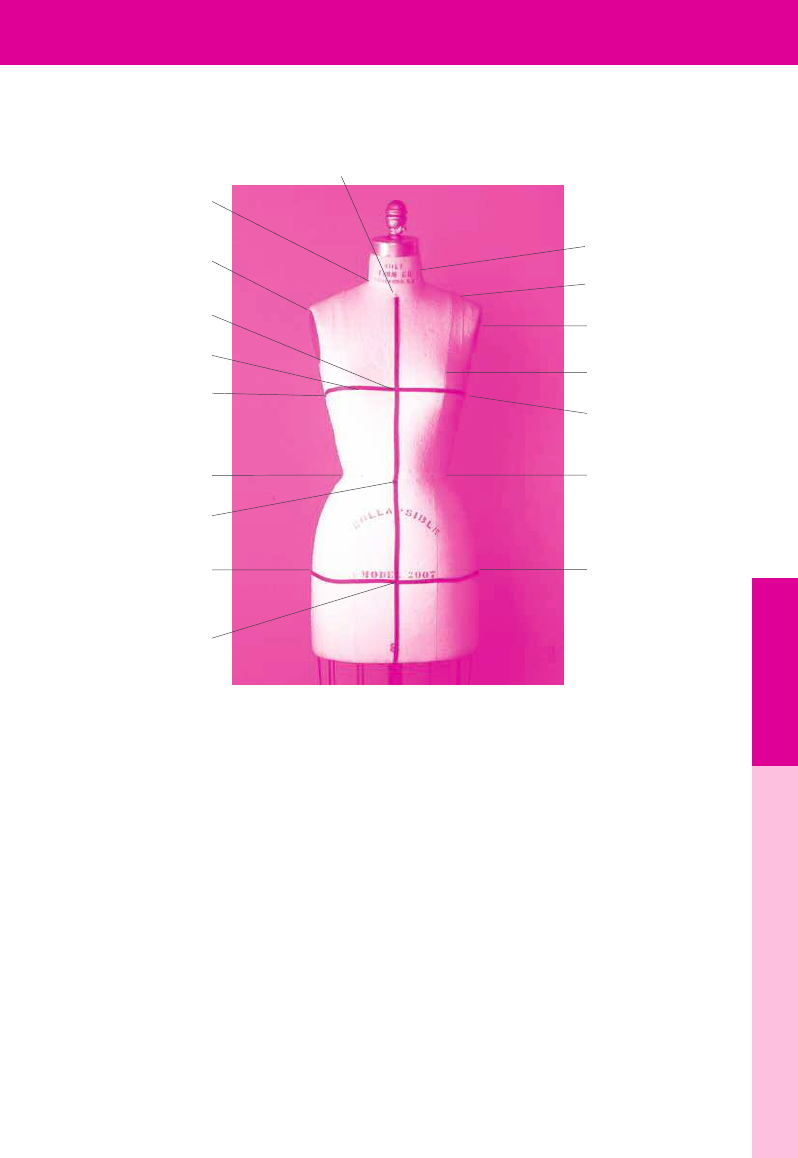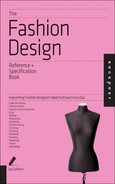
Job:02-30034 Title:RP-Fashion Design Ref and Spec Book
#175 Dtp:225 Page:162
162-175_30034.indd 162 2/27/13 4:55 PM
162 THE FASHION DESIGN REFERENCE + S PECIF ICATION BOOK
(Text)
Chapter 15: Patternmaking
Patterns are as invaluable to the fashion designer as plans are to the archi-
tect. Adding volume to a garment or eliminating fullness are the result of deci-
sions about fabric manipulation made during pattern drafting. Every restriction
and every bit of ease is built into the pattern. A creative individual armed with
a yardage of fabric and a few carefully placed pins can drape themselves into a
dress. Transferring this idea onto a at pattern, with all the information needed
to duplicate the process, is where the professional’s skill comes in.
D
D
p
p
b
T
s
m
In
w
A
u
In
fo
fo
Couturier Hardy Amies in the workroom with Miss Beard, head tter, 1952
Photograph by Popperfoto/Getty Images.
T
S
15
Job:02-30034 Title:RP-Fashion Design Ref and Spec Book
#175 Dtp:225 Page:162
162-175_30034.indd 162 2/27/13 4:55 PM

Job:02-30034 Title:RP-Fashion Design Ref and Spec Book
#175 Dtp:225 Page:163
Book
e:162
162-175_30034.indd 163 2/27/13 4:55 PM
(Text)
Dress Forms
Dress forms are not mannequins. They provide a live-model fit but are a lot more forgiving of
pin stabs. The base of a dress form is composed of layers of cardboard heat-fused with plaster
paste; it is covered in layers of jersey, which are covered, in turn, in linen. A spring mechanism
between the shoulders allows the form to collapse, making the removal of garments easier.
These body doubles are available in most standard sizes and can also be custom ordered for
special clients who cannot always come in for fittings. They are helpful both for fitting a gar-
ment and for the original development of a draped pattern.
In the design studio, small variations in a size can be made with wide bias strips of muslin
wrapped around the form to generate a gradual increase in the area requiring modification.
Adjustable dress forms that change sizes with the twist of a dial might be convenient for home
use or in special circumstances, but do not offer the stability that is the industry standard.
Industry forms are height-adjustable so the designer can work at a comfortable level. Pants
forms, body with legs, children’s and men’s, as well as maternity forms are available. A good
form will last a lifetime if treated well.
Photograph by Popperfoto/Getty Images.
Photograph by Tracy Aiguier.
THE DRESS FORM
Side neck
Center-front neck
Back neck
Shoulder seam
Armhole plate
Princess line
Bust line
Waistline
Hip line
Center-front hip
Side hip
Center-front waist
Side seam at waist
Side seam at bust
Bust apex
Center-front bust
Shoulder tip
15
Job:02-30034 Title:RP-Fashion Design Ref and Spec Book
#175 Dtp:225 Page:163
Book
e:162
162-175_30034.indd 163 2/27/13 4:55 PM

Job:02-30034 Title:RP-Fashion Design Ref and Spec Book
#175 Dtp:225 Page:164
162-175_30034.indd 164 2/27/13 4:55 PM
16 4 THE FASHION DESIGN REFERENCE + SPECIFICATION BOOK
(Text)
Tool Kit
For the draping and drafting of patterns, the designer needs a set of tools to facilitate the col-
lection and transfer of measurements, along with cutting and sewing instructions, onto a map
that anyone can use to create a sample garment.
Armscye (armhole curve)
Awl
Cloth weights
C-thru ruler
Dotted paper
French curve
Hip curve
Hole punch
Iron and board
Long stapler
L-square
Mechanical pencil
Muslin
Needle point tracing wheel
Notcher
Oak tag paper
Pattern hooks
Pattern punch
Pencils (black, blue, red)
Rotary cutter and cutting mat
Scissors (fabric and paper)
Sewing gauge
Straight pins
Style tape
Tailor’s chalk or wax
Tape measure
Yardstick
Patterns and Hooks
Photograpshs by Tracy Aiguier.
Patternmaking tools
S
T
s
A
s
a
t
th
th
th
o
a
F
F
st
m
d
b
in
T
h
th
b
ti
b
b
In
d
m
th
M
b
th
ex
T
b
c
e
15
Job:02-30034 Title:RP-Fashion Design Ref and Spec Book
#175 Dtp:225 Page:164
162-175_30034.indd 164 2/27/13 4:55 PM

Job:02-30034 Title:RP-Fashion Design Ref and Spec Book
#175 Dtp:225 Page:165
Book
e:164
162-175_30034.indd 165 2/27/13 4:55 PM
Patternmaking 16 5
(Text)
-
p
Photograpshs by Tracy Aiguier.
Slopers
The term sloper is commonly misused to describe a t pattern. As it relates to apparel, a
sloper is a pattern blank for a garment that does not include seam allowance or style lines.
A sloper has no seam allowance so that it can be used for generating new patterns based on
speci c dress-form/client/model measurements, or for modifying patterns that are based on
a successful model. Creating a sloper for a pair of pants that has been proven to have a great
t at the waist, hips, and rise eliminates the need to return to the drawing board to recreate
that particular t. The sloper can be traced onto paper and altered to create a new style with
the assurance of the same great t. Adding seam allowance at this point makes it a pattern
that can be used for the production of the garment. The removal of seam allowance is also an
option when generating patterns digitally—as handy a function as the one that reapplies seam
allowance to the pattern when modi cations are complete.
FLAT PATTERN DRAFTING
Flat pattern drafting can use the information generated from a draped pattern or be developed
strictly from measurements. Once the required set of key measurements has been deter-
mined, a two-dimensional grid is created on paper to represent a at version of a three-
dimensional form. The process can be compared to the design of a foldable cardboard gift
box, where at board is trimmed and scored in such a way that when folded it will transform
into a cube.
The pattern is drafted using a set of measurements and their relationship to one another:
how, where, and at what angles they intersect. The more detailed information that is collected
the better the t. Next, ease is introduced to areas that require extra exibility (across the
back, at the armhole, and across the seat are a few practical places), then darts are posi-
tioned as fold lines where needed to eliminate fullness, and nally seam allowance is added
beyond the stitching lines. A toile, also referred to as a muslin or t garment, is pinned or
basted together for a tting to make corrections and re ne the nal pattern.
In developing a first sample or custom garment, a set of measurements is established to
define the body for which it is being designed—a reflection of the target customer. These
measurements can come from a predetermined set of measurements or can be taken from
the existing client or fit model before creating any patterns for garments or samples.
Most body measurements are circumference measurements or length measurements. The
body circumference measurements are neck, chest, bust (at apex), waist, high and low hip,
thigh, knee, calf, ankle, bicep, elbow, and wrist, measured parallel to the floor, with the
exception of the waist.
The body length measurements are back-neck height, shoulder length, side neck to bust,
bust to waist, across chest and across back (armhole to armhole), center-back neck to waist,
center-front neck to waist, center-front waist to hip, center-back waist to hip, underarm to wrist,
15
Job:02-30034 Title:RP-Fashion Design Ref and Spec Book
#175 Dtp:225 Page:165
Book
e:164
162-175_30034.indd 165 2/27/13 4:55 PM

Job:02-30034 Title:RP-Fashion Design Ref and Spec Book
#175 Dtp:225 Page:166
162-175_30034.indd 166 2/27/13 4:55 PM
16 6 THE FASHION DESIGN REFERENCE + SPECIFICATION BOOK
(Text)
S
A
u
ke
ri
i
n
at
fu
th
A
lin
th
th
s
sa
ut
N
S
p
s
B
b
a
w
B
w
armhole, side neck to armhole bottom level (armhole depth), center back to shoulder, to elbow,
and to wrist; also waist to hip, knee, and ankle (center-front, center-back, and side seam),
waist level; crotch length (front waist to back waist), crotch height (seated); inseam, crotch to
knee, to ankle, and a record of the height, weight, bra size and cup size of the model.
These measurements create a virtual body which can be referenced while creating patterns or
garments whenever the physical body is not available. These measurements work for custom-
or mass-design production pattern and sample making.
GARMENT SPECS AND SAMPLING PROCESS
Even more important in the design production process is the garment’s specs. A wise design-
er or design house will have standard specs that make their fit recognizable and reliable for
the client. Garment specs are different than body measurements, but they include the mea-
surements of the body they are designed for, plus extra room for ease of movement or style
and design. They are recorded as circumference and/or length measurements. Oftentimes the
specs are an existing a house’s standard set of measures from which garment samples are
created following the basic measurements for bust, waist, hip, across shoulder, and so on, or
they can be developed over time. If a garment sample is found in the market that represents
the new designer’s ideal fit, the spec set can be generated from the sample garment. One
designer’s size small can be another designer’s size large, based on the customer. Inconsis-
tency in fit is a problem for the designer, the customer, and for sales.
Once a first sample is in hand, the sample must be thoroughly measured and recorded, so the
fitting designers and technicians know the exact measurements of the existing garment before
making changes. While fitting the model, adjustments will be recorded for the sample maker.
When a second sample is received, it must be thoroughly measured again to see if it fits the
requested specs. Discrepancies are and amendments are noted before a second fitting is
conducted. Many houses plan to have three rounds of sample fitting in the season’s develop-
ment to ensure all garments are being produced as required. Garments that cannot be satis-
factorily developed within the time frame allowed will be dropped from the line.
Retailers can void a contract if garments they have agreed to purchase are not meeting the
specs that were requested from a private label designer. A spec sheet will indicate how much
tolerance for error is allowed for each measurement. Specs exert a lot of control over fit. An
approved sample and spec will be graded up and down from the sample size into the full range
of sizes.
15
Job:02-30034 Title:RP-Fashion Design Ref and Spec Book
#175 Dtp:225 Page:166
162-175_30034.indd 166 2/27/13 4:55 PM
..................Content has been hidden....................
You can't read the all page of ebook, please click here login for view all page.
